The Empresses of Constantinople - Author: Joseph McCabe
The revolution which drove Martina from the palace set upon the throne a boy of eleven, Constans II. The wife whom he afterwards brought to share his splendour, and by whom he had three children, is not known to us even by name. We know only that when his crimes, or violent indiscretions, had rendered him so unpopular that he passed to Sicily, he sent for his wife and children. The Senators, however, had no mind to see the Court transferred to Italy. They detained the Empress and her children, and, as the life of Constans was shortly afterwards ended by his bath-attendant felling him with a soap-dish, the unknown Empress sank into complete obscurity.
His son and successor, Constantine IV., had so clear a title to the charge of brutality that no historian has ventured to dispute it, and we will trust that the Empress Anastasia, whose features and character are unknown to us, did not greatly lament the loss of a consort who could slit the noses of his royal brothers and castrate a noble youth for deploring the execution of his father. Nor can we think that she was happier under the reign of his son, Justinian II., since the only reference to her in the chronicle of his reign is that his favourite minister, a Persian eunuch, had her flogged in the sacred palace on one occasion. Her third and last appearance in history is even more tragic; but a new and quaint type of Empress meantime enters the scene, and in order to explain her arrival we must glance for a moment at the adventures of Justinian II.
82 Attaining the purple at the age of sixteen, Justinian seems at first to have sinned chiefly by the very natural blunder, in a young man, of admitting corrupt and extortionate ministers. A usurper then took advantage of his unpopularity to dislodge him from the throne, and sent him, with diminished nose, into exile at Cherson, on the Black Sea. Within a year Justinian had the satisfaction of hearing that his enemy had been forced by a new usurper to retire, also with diminished nose, into the tranquil shade of a monastery, and he proposed to regain his throne. The authorities of Cherson, however, decided to conciliate the new Emperor, Tiberius III., by sending Justinian to him in chains, and he fled to the land of the Khazars, who dwelt on the other side of the Black Sea. The Khazars were a wild Asiatic people, akin to the Huns, whose manners had been somewhat softened by contact with the Byzantine civilization, and their king, or chagan, not only received the fugitive with cordiality, but bestowed on him the hand of his royal daughter.
Theodora—a name conferred on her, no doubt, by Justinian in memory of the consort of his great predecessor Justinian I.—can hardly have boasted much beauty, being a Khazar, but she was not without spirit and character. She presently learned that her father had been bribed by Tiberius to surrender Justinian, and she warned him of his danger. Sending, in succession, for the two high officials who had been charged to arrest him, Justinian strangled them with his own hands and fled to Bulgaria, leaving his wife and infant daughter in the care of her father, who very amiably sheltered them. Within a year the faithful Theodora learned that she was mistress of the mighty city of the Greeks. Justinian had offered the hand of his daughter, then one year old, and some more solid advantages to the King of Bulgaria in exchange for an army, had laid siege to Constantinople, and had, with a few soldiers, crept through the water-conduit into the town and taken it.83 The appalling vengeance he wrought on his enemies and on the inhabitants, even to the babies, of Cherson may be read in history. It is, comparatively, an amiable trait in his character that he did not forget the yellow-skinned princess who had lightened the dark hours of his exile. She was brought with great pomp to the city, bringing two children to their truculent father, was crowned Empress, and enjoyed for a few years the undreamt-of splendour of the imperial palaces. Happily, she did not live to see the end of her husband’s savage vengeance. When a storm had threatened the life of Justinian on the Black Sea, his companions had urged him to disarm the divine wrath by forgiving his enemies. “If I spare them, may God drown me here,” he had replied, with more vigour than elegance. His orgy was closed by the inevitable assassination.
We catch a third and last glimpse of the Empress Anastasia at this point. The brood of Justinian was to be exterminated, and soldiers went to the palace of Blachernæ in search of Theodora’s boy. When they burst into the chapel they found the aged grandmother sitting, on guard, before the sanctuary. The six-year-old boy clung to the altar with one hand, and held a fragment of the “true cross” in the other, while his neck was loaded with the most sacred relics. But Byzantine piety was of a peculiar nature. The soldiers brushed aside the old lady, stripped the boy of his relics, took him out to the gate, and “cut his throat like a sheep.”
Three Emperors followed in six years, and came to violent ends. Then Leo the Isaurian (717–740) came upon the throne, and inaugurated the famous crusade of the Iconoclasts, or breakers of images. His wife Maria is known to us only as having received the title of Empress in 718, as a reward for bringing Constantine Copronymus into the world, and having scattered gold from her litter among the people as she was borne to St Sophia for the baptism of that ill-regulated infant. Another Asiatic princess then comes faintly into view,84 when, in his fourteenth or fifteenth year, Constantine marries a Khazar king’s daughter. The religious chroniclers would have us believe that she was endowed with much learning and piety, but the only ground of this remarkable claim is that she did not agree with her husband, as few women did, about the propriety of breaking the Virgin’s statues. After eighteen years of patient expectation she ushered a feeble infant, Leo IV., into the distracted Empire, and quitted it herself shortly afterwards. The Empress Maria succeeded to her place in the arms of Constantine in 750, and in 757 she left that very doubtful felicity to the Empress Eudocia. Eudocia was pious and fertile: it is all that we know of her. Nearing her first delivery she summoned the holy nun, Anthusa—whom her husband had had publicly stripped and whipped a short time before—and, in virtue of her prayers, presented Constantine with a son and daughter, simultaneously, shortly afterwards. Four other boys followed, and Eudocia, having behaved as a good Empress ought and furnished no material to the biographer, followed her two predecessors.
Meantime the famous Irene had entered the story of Byzantine life, and once more we are in a position to make a satisfactory study of Byzantine feminism. In the year 768, seven years before the death of Constantine V., Constantinople was delighted with a succession of festivities. On 1st April Eudocia was, after ten years of industrious maternal activity, crowned Empress, or Augusta, in the “banquet-room of nineteen tables,” with its golden roof and golden vessels, in the palace. On the following day, which was Easter Sunday, her eldest sons, Christopher and Nicephorus, were made Cæsars, and her third son, Nicetas, received the heavy title of nobilissimus (“most noble”), which gave the six-year-old boy a gold-embroidered mantle and a slender jewelled crown; so that the procession to church was headed by two Emperors, Constantine and young Leo, two Cæsars, and a “most noble,” all flinging gold and85 silver among the enchanted mob. But Leo was now approaching his twentieth year and must marry. The idea was mooted first of asking the hand of the daughter of Pepin the Frank, but it is said that the Western Christians frowned on the Kensitite heresy of the Eastern Court. So Constantine then resolved to seek a beautiful and eligible lady within his own dominions, and it was announced in the late summer that the prize had been awarded to Irene, the pride of Athens.
Irene was then a beautiful, talented and spirited girl of seventeen summers. As she had, apparently, no ancestors, and as Athens had become at that time a drowsy and almost obscure provincial town, we must suppose that—as she herself afterwards acted—imperial commissioners had been sent far and wide to examine candidates for the vacancy. Irene’s radiant Greek beauty, robust health, and lively intelligence pleased the officials; an imperial galley brought her to the palace of Hieria, on the Asiatic side; her qualifications were found to be adequate. There was one difficulty, and Irene gave early proof of her skill in casuistry in surmounting it. Not only was Irene a woman—and all women were on the side of the Virgin—but Athens was conservative in religion. Constantine demanded an oath, and Irene, with a large “mental reservation,” to use the elegant phrase of the experts in such matters, swore on the holy cross that she would not favour the worship of images.
Her story will turn largely on the question of Iconoclasm, and a few words on the subject may be useful. The real origin of Leo the Isaurian’s zeal against statues is obscure. Historians suggest the influence of the purer religion of Mohammed, but there was no cultural contact of Mohammedanism and Christianity, and an Isaurian soldier would hardly be the man to experience it if there were. When we find that the Iconoclasts went on to reject relics and monasticism and treat the Virgin in very cavalier fashion, I suggest that it was a Protestant or86 Rationalist movement, a spontaneous protest against the excessive superstition, clerical wealth and monastic parasitism of the time. It took strong root in the army; and we may assume that the permission to rifle wealthy churches, rather than any leaning to metaphysics, explains this zeal for advanced theology among the troops. Constantine, like his father, pressed the reform ferociously; and as monks and women were the chief recalcitrants, he fell upon the monks with grim determination. Their beards were oiled and fired: they were gathered in masses with nuns, and told to marry each other—as many did: they were forced to walk round the Hippodrome, to the delight of the mob, arm in arm with prostitutes. Even the reluctant patriarch of Constantinople was indelicately mutilated, driven on an ass round the Hippodrome, under a fire of spittle, and replaced by an obedient eunuch.
This was the Iconoclastic world into which the Athenian girl entered, armed with a mental reservation. From the palace of Hieria she went, at the beginning of September, to Constantinople, and her betrothal to Leo was celebrated in “the church of the Lighthouse.”
Three months later her probation was complete; on 13th December she received the wonderful crown of the Empresses, with its cascades of pearls and diamonds, in the gold-roofed banquet-room, and was married in the chapel of St Stephen within the palace.
Constantine remained on the throne for seven years, and Irene behaved, and avoided images, with the most exemplary propriety, until, in 775, the old Emperor joined his father in the eternal home to which the religious chroniclers luridly consign him. Still for some years Irene gave no sign of strong personality, unless we may see, as is probable, her influence in the events of the following year. She had borne a son in 770, and in 776 Leo was urged to admit this boy to a share of the Empire. The Emperor was delicate, possibly consumptive, and it will be remembered that he had five87 half-brothers, who offered rich material for intriguing eunuchs and discontented nobles. Irene was now a young woman of twenty-five, of strong and subtle intellect, and well acquainted with Byzantine history. Her obvious interest was to secure the succession for her son and exclude the children of Eudocia. Leo at first demurred to the crowning of the boy. He submitted that, if he died, the ways of Byzantium made it not unlikely that the child would be murdered. He was answered with an assurance that the whole Court and city were prepared to swear the most solemn allegiance to his son, and in the spring of 776 he prepared to associate the younger Constantine in his imperial power. It was becoming difficult in pious Constantinople to devise an oath sufficiently sacred to be taken seriously, and Leo exacted that all orders of the citizens should swear by the cross on its most solemn festival and then place a written record of their oath on the altar of the great church. On Good Friday, therefore, the officers, Senators, courtiers and various corporations of workers and idlers in the city, swore their mighty oath by the cross to know no sovereign but Constantine VI., and on the following day, when the last son of Eudocia, Eudocimus, was made a “most noble,” the written oaths were laid on the altar, to be carefully guarded by the patriarch—for a few years. On Easter Sunday Constantine was crowned in the Hippodrome in the early morning, and the glittering procession of Emperors, Cæsars, and “most nobles,” moved to the church, followed at a modest distance by Irene and her eunuchs and women.
Twelve months later the imperial family and the higher orders met in the gorgeous hall of the Magnaura palace for a different ceremony. It had been “discovered” that the Cæsar Nicephorus had conspired with the eunuchs and officers, and, when Leo announced the details—there was no trial—to the audience, it was at once decided that he be degraded to the rank of the clergy and banished to Cherson. One rival was put out88 of the way, and Leo continued to play with his caskets of jewels—his favourite occupation—and Irene to cultivate her policy of waiting. In her service was the eunuch Stauracius, a genius of intrigue and counter-intrigue, whose watchful servants could at any time detect or manufacture a conspiracy. On one occasion only, towards the end of her husband’s short reign, does Irene seem to have been indiscreet, though the indications are rather obscure.
Historians put it to the account of Leo that under him the fierce persecution of image-worshippers relaxed, but the question might be raised whether there was much occasion for persecuting. It is said that Irene secretly venerated images in her apartments and had about her a group of confidential devotees, waiting for the death of Leo; and the story runs that Leo, hearing of the conspiracy, forced his way into Irene’s apartments, and discovered two sacred statues hidden under a cushion. Whether or no it is true that Irene calmly lied—or made another mental reservation—and disowned the figures of Christ and His mother, it is certain that in the last year of his life Leo had a fit of Iconoclastic wrath, and numbers of palace officials and nobles were shaved into priests, dragged ignominiously round the Hippodrome, and forced to exchange the gilded service of the Empress for the austere service of the altar.
In view of this it is not surprising that, when Leo died a few months later, there was a faint rumour that Irene had poisoned him; though the more religious chroniclers tell us that, in his infatuation for jewels, he had taken from the church the rich crown which Maurice had suspended over the altars, put it on his sacrilegious head, which at once broke into fiery carbuncles, and perished miserably. We may take it that the delicate constitution of Leo IV. came to an end after a reign of four and a half years (in 780) and the Empress Irene entered upon her long, prosperous and blood-stained reign.
Constantine VI. was ten years old at the death of his father, and the administration naturally fell to Irene and her able, if unscrupulous, ministers. When all allowance has been made for the ability of her ministers, especially the eunuch-patrician Stauracius, it must be admitted that the Empress showed conspicuous talent and vigour, and brought about a wonderful restoration of the stricken Empire. Her abjuration of the Iconoclastic tenets not only brought comparative religious peace, in the course of time, but enabled her to strengthen her rule by friendly relations with the Papacy and with Charlemagne, whose star was rising in the West. The long and exhausting war in the East was brought to a close by diplomacy, and the military victories of Stauracius restored the rule of Constantinople in Greece and Thessaly. Prosperity brightened the Empire, and it almost returned to the happy position it had enjoyed under Justinian I. But from this brighter aspect of the reign of Irene, in which it is difficult to disentangle her action from that of her ministers, we must turn to events in which her character is more clearly, if less favourably, seen.
Six weeks had not elapsed since the death of Leo when it was announced that a dangerous conspiracy had been discovered, the object of which was to put the royal half-brothers of Leo on the throne. We can well believe that there was some discontent at the rule of a woman and a child, and that the feeble sons of Eudocia were ever disposed to listen to ambitious courtiers, but the discovery was opportune. It removed at one sweep all who seemed to be in a position to dispute Irene’s rule. The three Cæsars and the two “most nobles,” and a crowd of nobles and officers who were suspected of favouring them, were scourged, tonsured or exiled. Indeed, lest there should be any later error as to the clerical status of the children of Eudocia, Irene forced them publicly to administer the sacraments to the people in the great church. It was Christmas Day, and a vast crowd assembled to see90 the royal uncles dispensing the consecrated bread under the eyes of the vigorous Empress and her son.
The cruel spectacle was resented by many, and Elpidius, whom Irene had made Governor of Sicily, rebelled. Irene ordered the local officers to send him in chains to Constantinople, and, when they refused, she sent a fleet which quickly dislodged him and punished the rebels. Unfortunately, we read that the “most pious” Empress, as the admiring chroniclers call her, so far lost her temper as to flog the wife and children of Elpidius, and drive the innocent woman, with shorn hair, into a nunnery. A more amiable way of strengthening her throne was about the same time discovered by some courtier. A marvellous ancient tombstone was brought to Constantinople, and citizens gazed with awe on the inscription: “Christ will be born of the Virgin Mary, and I believe in him. Sun, thou shalt see me again one day under the reign of Constantine and Irene.” As this stone was certified to have been taken by a Thracian peasant from the tomb of some prehistoric “giant,” it did much to discredit the more rationalistic Iconoclasts, who scouted the virginity of Mary, and the opposition to the divine mission of Irene.
The time was not yet ripe, however, for an open disavowal of the Iconoclasts; the heresy was too deeply rooted in the army and the more cultivated circles of the city. Irene thought for a moment of an alliance with Charlemagne, and begged the hand of his daughter Rotrud for her son. The offer was cordially received, and Byzantine eunuchs were sent to initiate the Frankish maiden into the mysteries of the Greek tongue and Greek etiquette. The fame of Charlemagne now filled the world, and the young Constantine eagerly looked for the alliance with his daughter. It would be interesting to speculate what influence such an alliance would have had on the fortunes of Europe, and there can be no doubt that Irene committed a criminal blunder in withdrawing91 the proposal on what we must regard as selfish grounds. The only plausible reason that can be suggested is that she feared that her son might become a monarch in reality as well as name under the influence of Charlemagne, and she was determined to be at least co-ruler. The victories which Stauracius had meantime won in Greece and Thessaly must have given her greater confidence in her own resources. In 783 she proceeded herself with a large army—not forgetting the organs and other musical instruments of the Court, the chronicler says—to pacify and restore the province of Thrace.
She now felt strong enough to restore the worship of images. At the end of the year 783 the Iconoclastic archbishop Paul mysteriously retired from his see. Irene called a meeting of the notables in the Magnaura palace, and from the marvellous golden throne she announced that Paul had been stricken with deep penitence for his opposition to images and had retired to expiate his sin. She suggested that her secretary Tarasius should be made archbishop, and the nobles and clergy faithfully echoed the name of Tarasius. The secretary then protested that he too had misgivings on the image question, and would take office only on condition that a Church council was called to decide upon it. Within a month or two Irene had brought to Constantinople a crowd of bishops and heads of monasteries, and a fiery discussion proceeded in the church of the Apostles. The Iconoclasts were, of course, in a minority. Suddenly the doors were forced, and a troop of soldiers entered, with drawn swords, and threatened to make an end to Tarasius and his monks. “We have won; thank God, those fools and brutes have done no harm,” was the exultant cry of the Iconoclastic bishops—I translate literally from Theophanes15—and the meeting hurriedly dispersed.
92 Irene once more resorted to the kind of diplomacy of which she was a mistress. The rumour was spread that the Saracens were advancing, and the guards were shipped to the Asiatic side and marched toward the south. When they had reached some distance from the city, a message came from Constantinople that the war had been averted, and they might send their arms or equipment to the capital before returning themselves. They were then scattered over the provinces and the metropolitan guards were recruited from the orthodox ranks. The bishops and monks were convoked again, in the Council of Chalcedon, and in the last sitting of the Council, which was held in the Magnaura palace, the cult of images was formally restored.
In the meantime Irene had resumed the work of finding a wife for her son. If we are right in assuming that she rejected the daughter of Charlemagne in order that Constantine should not have any strength independently of her, we can understand her next procedure. One of those innumerable “lives of the saints” which have transmitted to us a few precarious fragments of genuine and interesting information gives us a very romantic version of the rise of the next Empress. In a remote Cappadocian village dwelt a very pious man who had won a local reputation for sanctity, and impoverished his family, by his generous almsgiving. He had three daughters, whose lives and prospects must have been prosy enough in their rude village until romance entered it one day in the person of an imperial commissioner. He was one of many sent all over the Empire by Irene in search of a mate for her son, and it seemed to him that the daughters of Philaretus corresponded to the standard given to him—a standard which specified the height and the size of the feet of the candidates as well as more material features.16 They were taken to Constantinople, with93 numbers of other candidates for the glass slipper, and Maria, a beautiful maiden of eighteen, was chosen for the lofty honour. It sounds like a modified version of the story of Cinderella, but it was not the first time that obscure maidens had been chosen for imperial dignity on their looks, and the most reliable authority, Theophanes, tells us that Irene sent one of her officers into distant Armenia—Maria is variously described as Cappadocian, Paphlagonian and Armenian—for the obscure girl. She was married to the Emperor in November 788, but we cannot end, as story-tellers do, by saying that she was happy ever afterwards.
Constantine was now a youth of eighteen, and had courtiers of his own. With their aid he perceived that, although rescripts went out in the names of “Constantine and Irene,” the government was entirely in the hands of Irene and her ministers. He had keenly desired the daughter of Charlemagne, and he resented the forcing upon him of a village maiden. The year following his marriage was one of bitter discontent and secret whispering. Stauracius, however, or Irene, watched the conspirators closely, and in January 790 the net was drawn round them. They had intended to banish Irene to Sicily, and they now found themselves on the way to Sicily, their backs sore from the scourge and their heads marked with the odious sign of clerical office. Constantine himself was flogged, and confined for some time to the palace; it was decreed that henceforth the name of Irene should precede that of her son; and a formidable oath was imposed on the troops that they would not suffer Constantine to rule while she lived.
But the counsels of eunuchs and women, however vigorous they be in their class, are apt either to fall short of, or pass beyond, the golden mean in the game of politics. Regiment after regiment took the oath, until at last the troops in Armenia refused to submit to feminine rule. Irene sent the eunuch Alexius to persuade or coerce94 them. They made him their commander, spread the rebellion among other troops, and at length an army besieged the palace and dictated terms. Stauracius was scourged, tonsured and deported to Armenia; Irene was deposed and had to retire to a new palace—the Eleutherian palace—which she had built and stored with treasure for emergencies. The lament of Theophanes at this turn of the wheel, in which he sees the personal action of the devil, is equal to his naïve praise of all the tricks of Irene to secure and hold power in the cause of true religion.
In spite of that zeal for true religion, the modern reader will not have followed the career of Irene up to this point with unalloyed admiration. She was essentially a casuist, the very embodiment of the Byzantine religious spirit. Chaste she undoubtedly was, though we shall presently find her acting in that regard in drastic contradiction to the teaching of the Church; she was generous, even extravagant, with money, and she showed a sincere concern for the welfare of her subjects within the limits of her own ambition; but she betrays from the start that lack of moral scrupulousness which too often accompanies fervent piety in Byzantine women, and the bitter disappointment which closes the first part of her reign will now make her more unscrupulous than ever.
It was in October 790 that Irene was deposed. Fourteen months afterwards we find her returning to imperial power and making a fearful use of it. Constantine had yielded to her pressure and that of the nobles devoted to her, and again proclaimed that she was Empress and co-ruler of the Empire. The Armenian troops at once protested against the change, and, as their commander, Alexius, was in Constantinople at the time, he was scourged and converted into an abbé malgré lui. An expedition against the Bulgarians failed shortly afterwards, and, whether the failure did really lead to a95 conspiracy, or the plot was invented to serve the purpose of Irene and Constantine, a terrible clearance was made of their possible opponents. Alexius and Nicephorus (the uncle of the Emperor who had been made a cleric) had their eyes cut out; and three other sons of Eudocia were brought from their clerical homes and had their tongues cut. We must not too readily implicate Irene in these barbarities. She had not returned to her former influence and activity, and it was Constantine himself who led an army against the insurgents in Armenia and made a terrible end of their rebellion. In view, however, of Irene’s later behaviour, it is probable that she agreed to, if she did not inspire, these proceedings, and the authorities assure us that she now began to make selfish profit of the unpopularity of her son and encourage him in licence.
We have as yet said nothing of the imperial life of the young woman who had passed from her village home to the palace. The reason is that she seems to have been one of those admirable Empresses who impress the chroniclers only when they bear children or suffer misfortune. Maria had borne two daughters to Constantine, and the year of her misfortune was at hand. Constantine had never loved his wife and had freely sought consolation elsewhere; and in the year 794 his eye fell on a charming lady of his mother’s suite. Whether this lady was too chaste or too ambitious to admit his passion irregularly, we cannot say, but we have the emphatic assurance of the authorities that Irene encouraged the passion, and supported her son in his proposal to divorce Maria, in order still further to weaken his position. If such an act seem beyond the range of a mother’s ambition, I can only say that far worse is to follow.
On 3rd January 795, the unfortunate Maria was deposed from her dignity, exchanged her imperial robes for the rough black dress of a nun, and, with shorn hair,96 passed to a convent; and before the end of the same year the more fortunate Theodote was transferred from the service of Irene’s chamber (cubicularia) to the imperial dignity. It need hardly be said that this procedure was violently opposed to the solemn teaching of the Church, which now regarded marriage as absolutely indissoluble. The courtly patriarch Tarasius, who had been converted from a very secular secretary into an archbishop, proved accommodating enough; he declined to perform the marriage, but he permitted some enterprising priest named Joseph to do so, and he sanctioned the transfer of Maria to a nunnery. But the monks of the Empire raised once more their formidable chant of execration, and showered epithets on the Emperor and the archbishop. The great monastery of Saccudion, in Bithynia, was the centre of the agitation, under its vigorous abbot Plato.17
The next move of Irene was to espouse the cause of the monks who fulminated against her adulterous son and his “Jezebel,” and were punished for doing so. If we feel a scruple about admitting so malignant a course in a Christian mother, we must remember that these things are ascribed to her by chroniclers who are full of admiration for her piety, and that the tragic end of the story is quite beyond doubt. Constantine lost ground, and Irene watched her opportunity. It came in the month of September 796, when mother and son went, with a large and distinguished company, to take the hot baths at Prusia. Theodote had remained behind, so as to be near the Porphyra palace, and she presently sent a message that a son was born. Constantine galloped in delight to the city, and Irene set to work. By amiable conversation and secret gifts she won a number of the97 officers, and the conspiracy quietly proceeded when they returned to Constantinople. The following summer Constantine set out against the Saracens, and Irene, fearing that he might return with glory and renewed popularity, for he was a skilful and vigorous soldier, determined to strike.
Constantine was recalled to the city by some false intelligence, and as he went one day (17th June) from the Hippodrome to join his wife (whose baby had recently died) in the palace of Blachernæ, he was attacked. He escaped, and fled by boat to the Asiatic side, where Theodote joined him. The position was now critical, as a number of nobles and officers were with Constantine, and Irene heard that others were daily crossing the water. For a moment she trembled and thought of sending bishops to ask her son to allow her to retire into private life, but there remained one device. Among the courtiers with Constantine were some whom she had already compromised, and she sent a secret message to these men to the effect that she would reveal their perfidy to the Emperor if they remained with him. The stratagem succeeded. In the early morning of 15th August the Emperor was brought, bound, to his palace and lodged in the Porphyra; and there, in the very palace in which he had been born, his eyes were brutally cut out by the knives of the soldiers at the ninth hour of the day. Some of the chroniclers observe that the work was done in such a way that the men really intended to kill Constantine. That is misleading, since it would have been perfectly easy to kill him, whereas we know that he lingered in confinement in the Therapia palace for some years. The truth probably is that Irene’s casuistry permitted the horrible mutilation, but forbade the murder, of her son; but her agents probably concluded that if they accidentally and unintentionally killed Constantine there would be few tears shed.
It would be difficult to find a parallel to this horrible deed in the long story of the pagan Empresses, and we98 press on to the conclusion of Irene’s reign. For several years she continued to rule the Empire in peace and prosperity. One or two feeble revolts were made, and more eyes were cut from their sockets, but the year 799 opened with little sign of trouble. Decrees went forth in the name of “Irene, the great king and autocrat of the Romans.” She built convents and established charitable foundations. She gladdened the hearts of the poor by remitting taxes and import duties, and scattering money amongst them as she rode to church in a golden chariot drawn by four white horses, the reins of each held by one of the highest dignitaries of the Empire. The Pope blessed her—he had put out the eyes of his predecessor—and the great Charlemagne sent legates to ask her hand in marriage. And the blind Emperor lingered in his palace-prison with his faithful Theodote, waiting for the thunder of Jupiter.
In the year 800 the shadow of the avenger seemed to come over the palace. Irene had two powerful ministers, Stauracius (who had, of course, returned from the service of the altar) and Aetius, and their quarrels filled the palace and the heart of Irene with bitterness. In 799 she had been dangerously ill, and their intrigues had doubled. She recovered, and Stauracius determined to make a bold attempt to secure the purple. His conspiracy was discovered, and Irene, holding a council in the gold-roofed dining-hall, decreed that no military officer was to approach Stauracius. The sentence seems mild, but the truth was that, in spite of doctors and priests who lied to him even as he spat blood, Stauracius was dying. He passed away in June, and Aetius commanded the palace.
The end came in 802. Aetius had frustrated the proposal of a marriage of Charlemagne and Irene, who seems to have favoured it (she was still only in her fiftieth year), because he designed to secure the purple for his brother and thus maintain his position. But the legates of Charlemagne lingered in Constantinople, and99 witnessed the fall of the great Empress. On the evening of 31st October 802, when Irene lay ill in her Eleutherian palace, a group of nobles and officers knocked at the door of the Chalke and summoned the guard. They had, they said, been sent by Irene to put Nicephorus, the “chancellor of the exchequer,” on the throne; she wished to forestall Aetius. In the darkness and confusion they were admitted, and they took possession of the palace and set guards round the Eleutherian palace. Almost before dawn the next morning they conveyed Nicephorus to the great church to be crowned, and, although Irene’s liberality had won the people and they gathered in the square to damn Nicephorus and the archbishop and raise cheers for Irene, they were powerless. The nobles and officers were resolved to tolerate the insolence of Aetius no longer.
Irene, sick and dispirited, was incapable of making one of those spurts of energy or astute stratagems which had so often saved her. When the hypocritical Nicephorus came to visit her in her apartments, she quietly begged that she might be permitted to end her days in her Eleutherian palace. He had often been a guest at her table and grossly deceived her; even the nobles were yet to learn what a brute they had put on the throne. He promised that if she would swear on the cross to give up the whole of the imperial treasure, she should retire to her palace. It was believed that treasure was hidden in various places in that labyrinth of palaces; even the blind Constantine was brought forth to say in which wall a certain treasure was hidden. Irene swore her last oath, gave a list of the hiding-places—and was promptly imprisoned in a monastery she had built on the Princes’ Islands, a group of small islands, in view of the palace, on the Sea of Marmora.
Constantinople seems to have been deeply moved, and a month later she was removed to a dismal prison on the island of Lesbos. There, under a strong guard, rigorously isolated from her friends,100 she spent nine miserable months reflecting on the strange career she had run since she had left Athens in the pride of her youth and beauty. She died on 9th August 803, and was buried in her monastery on the Princes’ Islands.
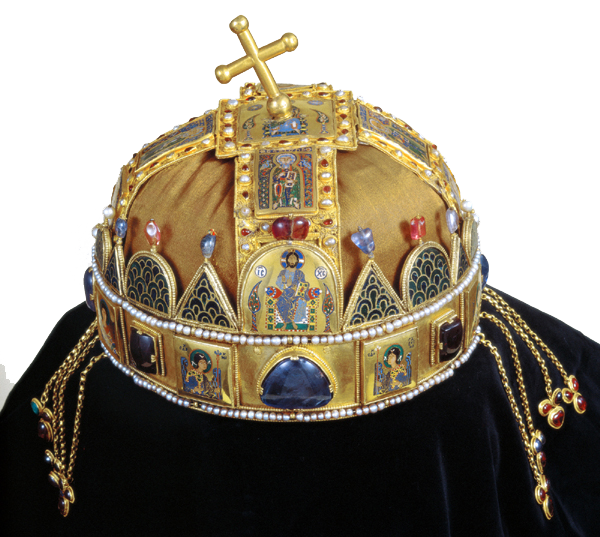
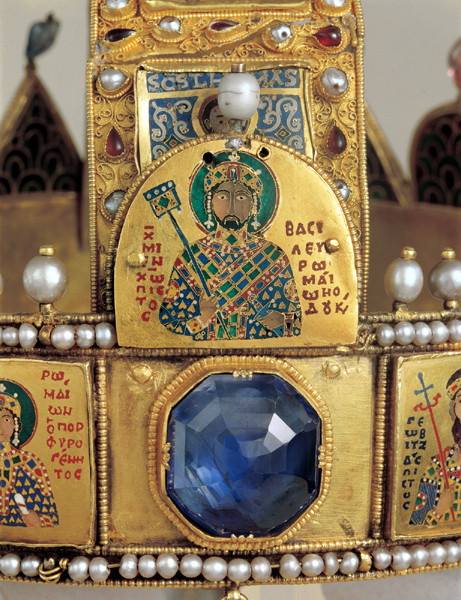
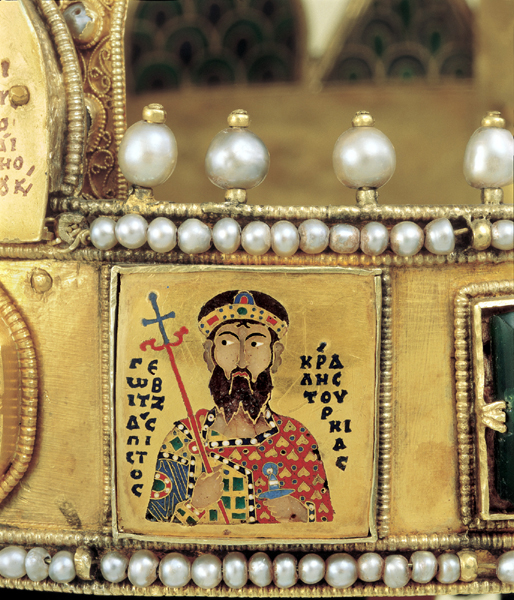
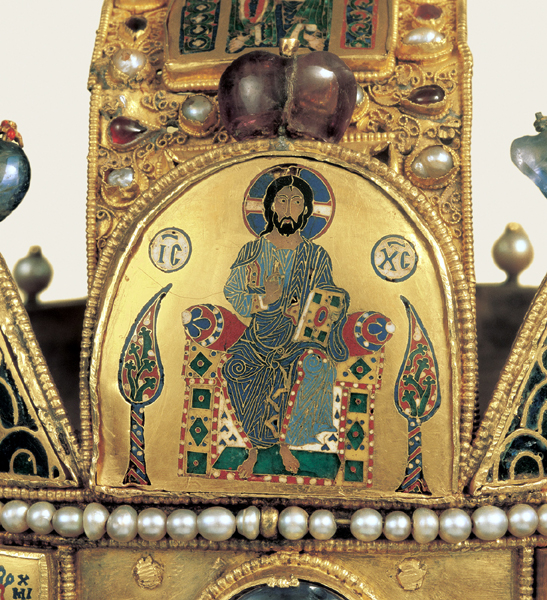
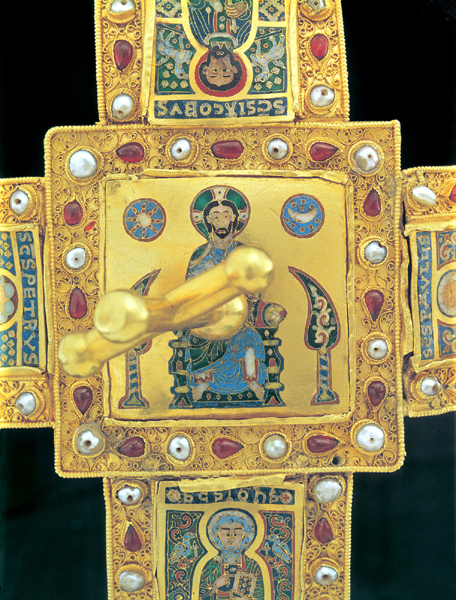
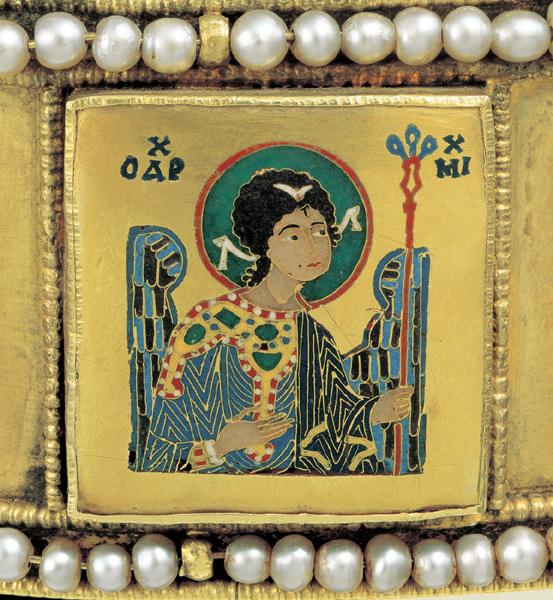
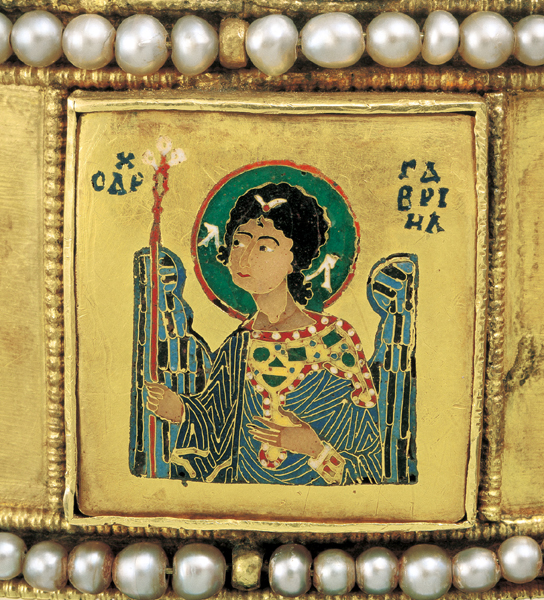
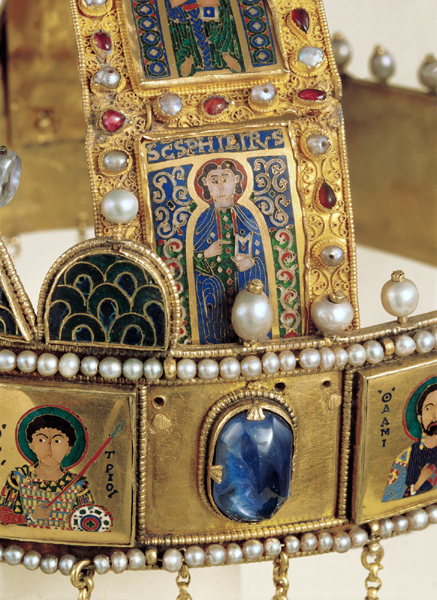
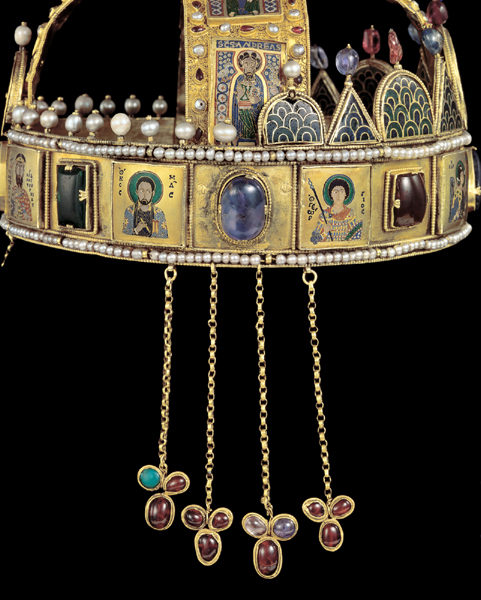
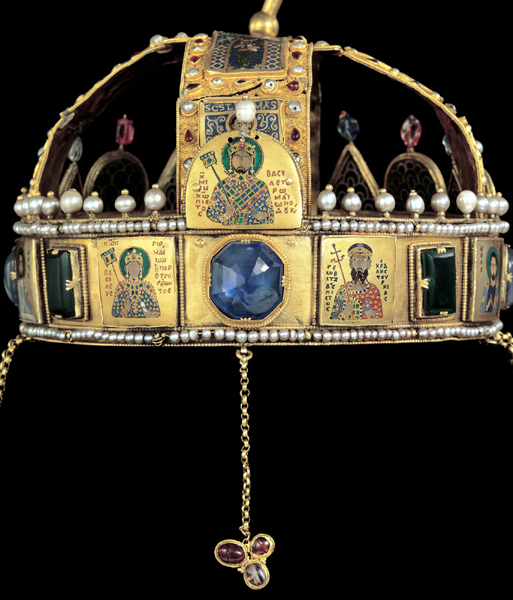





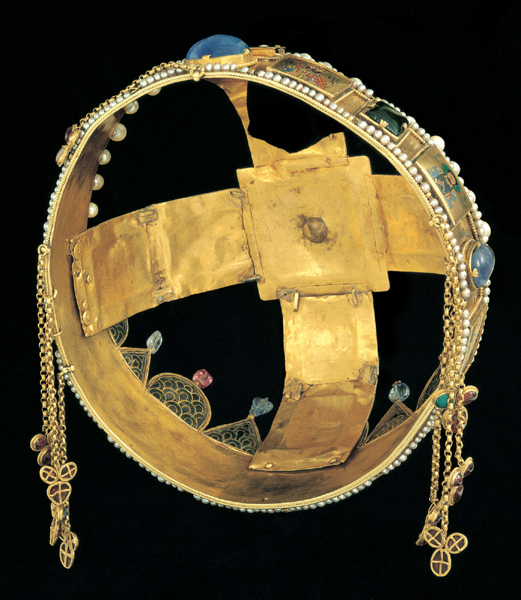
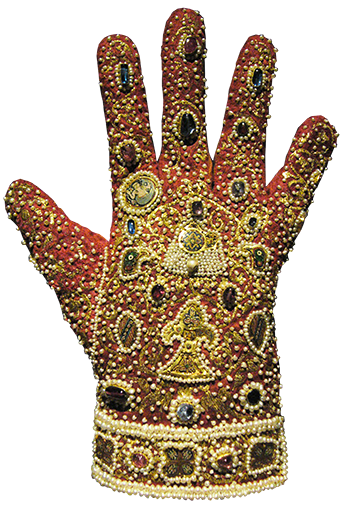
 click here for icons of christ
click here for icons of christ click here for icons of the theotokos
click here for icons of the theotokos click here for icons of angels
click here for icons of angels click here for icons of saints
click here for icons of saints








